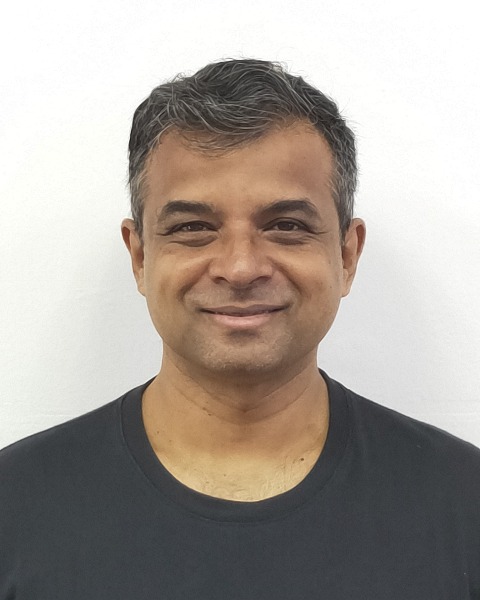Neuroplasticity
The effect of Hemiparesis on biomechanics and brain activity as seen in the rehabilitation of stroke subjects and elite athletes.
Wednesday, November 1, 2023
2:15 PM - 2:21 PM
Location: Station 11

Subhasis Banerji, PhD (he/him/his)
Managing Director
Synphne Pte. Ltd., New Jersey, United States
Poster Presenter(s)
Research Objectives: To understand the nature of hemiparesis and its implications in rehabilitation strategies in diverse domains such as stroke and sports performance. While hemiparesis due to stroke is exacerbated due to compensation, hemiparesis may manifest in peak performance athletes after injury or overtraining.
Design: Case studies in stroke rehabilitation and elite athletes experiencing performance difficulties who have used a wearable neurorehabilitation device, SynPhNe, were reviewed. Observational data and measurements of brain (electroencephalography) and muscle (electromyography) bio-signals captured with the device were used to gain insight into the nature of hemiparesis in the two diverse groups.
Setting: Study settings were institutional outpatient center and private practice
Participants: Stroke patients (n=6) in chronic care outpatient setting and athletes (n=6) in private practice setting
Interventions: Subjects were subjected to one assessment session followed by 6 sessions of 60 min each on the Synergistic Physio-Neuro wearable device SynPhNe. Subjects responded to real-time brain and muscle biofeedback on a computer screen while trying to watch and follow videos showing arm and hand movements and tasks.
Main Outcome Measures: Observational posture data and measurements of brain (electroencephalography) and muscle (electromyography) bio-signals were captured with the device while performing simple movements and tasks with the hand. Analysis of these were used to indicate one-side dominance, compensatory tendencies and hemiparesis
Results: Hemiparesis manifests as a weakness and loss of mobility on one side and a simultaneous stiffness and reduced mobility on the so-called unaffected side. Asymmetry was also noticed in hemispheric brain activity during rest and during movement using the Modified Brain Symmetry Index.
Conclusions: A better understanding of how hemiparesis manifests is important for rehabilitation after stroke and injuries suffered during peak performance. Rehabilitation protocols must address both the affected and non-affected sides for effective, non-compensatory recovery.
Author(s) Disclosures: Author is the inventor of the SynPhNe wearable device and Managing Director at SynPhNe Pte. Ltd. which markets the device. The author was involved in the training and recruitment of subjects in this study but was blinded to assessments, sessions and outcomes measures
Design: Case studies in stroke rehabilitation and elite athletes experiencing performance difficulties who have used a wearable neurorehabilitation device, SynPhNe, were reviewed. Observational data and measurements of brain (electroencephalography) and muscle (electromyography) bio-signals captured with the device were used to gain insight into the nature of hemiparesis in the two diverse groups.
Setting: Study settings were institutional outpatient center and private practice
Participants: Stroke patients (n=6) in chronic care outpatient setting and athletes (n=6) in private practice setting
Interventions: Subjects were subjected to one assessment session followed by 6 sessions of 60 min each on the Synergistic Physio-Neuro wearable device SynPhNe. Subjects responded to real-time brain and muscle biofeedback on a computer screen while trying to watch and follow videos showing arm and hand movements and tasks.
Main Outcome Measures: Observational posture data and measurements of brain (electroencephalography) and muscle (electromyography) bio-signals were captured with the device while performing simple movements and tasks with the hand. Analysis of these were used to indicate one-side dominance, compensatory tendencies and hemiparesis
Results: Hemiparesis manifests as a weakness and loss of mobility on one side and a simultaneous stiffness and reduced mobility on the so-called unaffected side. Asymmetry was also noticed in hemispheric brain activity during rest and during movement using the Modified Brain Symmetry Index.
Conclusions: A better understanding of how hemiparesis manifests is important for rehabilitation after stroke and injuries suffered during peak performance. Rehabilitation protocols must address both the affected and non-affected sides for effective, non-compensatory recovery.
Author(s) Disclosures: Author is the inventor of the SynPhNe wearable device and Managing Director at SynPhNe Pte. Ltd. which markets the device. The author was involved in the training and recruitment of subjects in this study but was blinded to assessments, sessions and outcomes measures
Learning Objectives:
- Understand how neural and muscle asymmetry manifests in diverse groups such as stroke patients and elite athletes
- Translate EEG and EMG and observational data findings into more comprehensive rehabilitation and injury prevention programs
- Potentially modify peak performance regimens for sustained performance training and injury prevention

.jpg)
